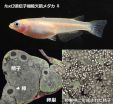Researchers at Case Western Reserve and UT Southwestern Medical Center this week announced that they have taken significant steps toward turning this once-improbable idea into a vivid reality. In a study published in the June 12 edition of Science, they detail how a new drug repaired damage to the colon, liver and bone marrow in animal models -- even going so far as to save the lives of mice who otherwise would have died in a bone marrow transplantation model.
"We are very excited," said Sanford Markowitz, MD, PhD, the Ingalls Professor of Cancer Genetics at the university's School of Medicine and a medical oncologist at University Hospitals Case Medical Center's Seidman Cancer Center. "We have developed a drug that acts like a vitamin for tissue stem cells, stimulating their ability to repair tissues more quickly. The drug heals damage in multiple tissues, which suggests to us that it may have applications in treating many diseases."
The institutions collaborating on this work next hope to develop the drug -- now known as "SW033291" -- for use in human patients. Because of the areas of initial success, they first would focus on individuals who are receiving bone marrow transplants, individuals with ulcerative colitis, and individuals having liver surgery. The goal for each is the same: to increase dramatically the chances of a more rapid and successful recovery.
The key to the drug's potential involves a molecule the body produces that is known as prostaglandin E2, or PGE2. It is well established that PGE2 supports proliferation of many types of tissue stem cells. Markowitz and University of Kentucky Professor Hsin-Hsiung Tai earlier had demonstrated that a gene product found in all humans, 15-hydroxyprostaglandin dehydrogenase (15-PGDH), degrades and reduces the amount of PGE2 in the body.
Markowitz, also a Harrington Discovery Institute Scholar-Innovator, and James K.V. Willson, MD, a former Case Western Reserve colleague now at UT-Southwestern, hypothesized that inhibiting 15-PGDH would increase PGE2 in tissues. In so doing, it would promote and speed tissue healing. When experiments on mice genetically engineered to lack 15-PGDH proved them correct, the pair began searching for a way to inactivate 15-PGDH on a short-term basis.
The preliminary work began in test tubes. Yongyou Zhang, PhD, a Case Western Reserve research associate in Markowitz's lab and a lead author on the study, developed a test where cells glowed when 15-PGDH levels changed. Zhang then traveled to UT Southwestern's Harold C. Simmons Comprehensive Cancer Center, where Willson serves as director. Zhang and UT Southwestern researchers Bruce Posner, PhD, and Joseph Ready, PhD, collaborated to comb through the center's library of 230,000 different chemicals. Ultimately they identified one chemical that they found inactivated 15-PGDH.
"The chemical, SW033291, acts in an incredibly potent way," Markowitz said. "It can inactivate 15-PGDH when added at one part in 10 billion into a reaction mixture, which means it has promise to work as a drug."
A series of experiments showed that SW033291 could inactivate 15-PGDH in a test tube and inside a cell, and, most importantly, when injected into animal models. The third finding came through collaboration between Markowitz and Stanton L. Gerson, MD, director of the Case Comprehensive Cancer Center, UH Seidman Cancer Center, and the National Center for Regenerative Medicine, as well as the Asa and Patricia Shiverick-Jane Shiverick (Tripp) Professor of Hematological Oncology.
Case Western Reserve research associate Amar Desai, PhD, worked between the Markowitz and Gerson laboratories to determine the effect of SW033291 on mice that had received lethal doses of radiation and then received a partial bone marrow transplant. Without SW033291, the animals died. With it, they recovered.
From there, more detailed studies showed that mice given SW033291 recovered normal blood counts six days faster than mice that were transplanted without receiving SW033291. In addition, SW033291-treated mice showed faster recovery of neutrophils, platelets and red blood cells. Neutrophils battle infection, platelets prevent bleeding, and red blood cells deliver oxygen throughout the body.
In addition, Desai's work showed that when SW033291 increases PGE2 in bone marrow, the body also begins to produce other materials that bone marrow stem cells need to survive. Finally, these benefits emerged without any adverse side effects, even at SW033291 doses much higher than would be required for 15-PGDH inhibition.
When investigators treated mice with other diseases, the SW033291 drug again accelerated tissue recovery. For example, the investigators teamed with Fabio Cominelli, MD, PhD, a Case Western Reserve Professor and Chief of the Division of Gastroenterology and Liver Disease, to study a mouse model of ulcerative colitis. SW033291 healed virtually all the ulcers in the animals' colons and prevented colitis symptoms. In mice where two-thirds of their livers had been removed surgically, SW033291 accelerated regrowth of new liver nearly twice as fast as normally happens without medication.
Because bone marrow, colon, and liver are significantly different tissues, the investigators believe the pathway by which SW033291 speeds tissue regeneration is likely to work as well for treating diseases of many other tissues of the body. However, the next stages of the research will concentrate on three diseases where SW033291 already shows promise to provide dramatic improvement.
In bone marrow transplants, for example, effects of SW033291 in accelerating tissue growth would provide the body the cells required to fight off the two most common and sometimes fatal complications, infection and bleeding. For those suffering the debilitating impact of colitis, accelerating tissue growth could heal colon ulcers more quickly, which in turn could allow patients to take lower dosages of other medications that treat colitis -- some of which have serious side effects. Finally, the promise of tissue growth could increase survival rates for patients with liver cancer; in some cases today, physicians are unable to perform surgery because the amount of the liver to be removed would be so great as to pose severe risk to the patient. But having a drug to accelerate the liver's regrowth could make surgery a viable option.
The team's next step will be to complete studies showing safety of SW033291-related compounds in larger animals, a required part of the pathway to secure approval from the U.S. Food and Drug Administration for trials in humans. If the drugs prove safe and effective in those clinical trials, they could then become available for general use by physicians. Investigators hope to partner with pharmaceutical companies to be able to start human trials within three years.
"These are thrilling times for us as researchers, and it is also an exciting time for Case Western Reserve," Markowitz said. "In Cleveland, there has been a major effort in the last two to three years to figure out how all our institutions can together work to develop drugs. This discovery is really something we should celebrate. It helps put us on the map as a place where new drugs get invented."
Markowitz added that this research received crucial financial assistance from Case Western Reserve University School of Medicine's Council to Advance Human Health (CAHH), from the Harrington Discovery Institute at University Hospitals, and from multiple National Institutes of Health grants that included the Case GI SPORE, led by Markowitz, and the National Center for Accelerating Innovation at the Cleveland Clinic. Additional support was received from the Marguerite Wilson Foundation; the Welch Foundation; the Cancer Prevention & Research Institute of Texas; Inje University; and the Korean National Research Foundation. Generous major gifts also came from the Leonard and Joan Horvitz Foundation and the Richard Horvitz and Erica Hartman-Horvitz Foundation.
Markowitz said the authors' contributions to this research are truly a tribute to the powers of collaboration. Senior authors Hsin-Hsiung Tai, Stanton L. Gerson, Joseph M. Ready, Bruce Posner, James K.V. Willson and Markowitz provided substantial leadership. Markowitz and Willson, former director of the Case Comprehensive Cancer Center and now director of the Simmons Cancer Center at UT Southwestern, initiated the project to study the potential of inhibiting 15-PGDH as a tissue-healing treatment strategy. Tai, at the University of Kentucky, Lexington, originally discovered 15-PGDH and tested SW033291 as a 15-PGDH inhibitor. Gerson and Markowitz partnered to show the SW033291 drug is effective for regenerating bone marrow in mice. Ready, a UT Southwestern chemist, synthesized SW033291 for the studies and has made multiple other highly promising derivatives of the compound. Posner, also a chemist from UT Southwestern, oversaw the search through the 230,000 compounds in the UT Southwestern chemical library.
Lead authors Yongyou Zhang, Amar Desai, Sung Yeun Yang, Ki Beom Bae, Monika I. Antczak, Stephen P. Fink and Shruiti Tiwari contributed equally to the scientific investigation. Zhang, Case Western Reserve, led the experiments that identified the drug. Desai, Case Western Reserve, performed experiments that showed that SW033291 works in bone marrow transplantation in mice. Yang and Bae, now at Inje University in Korea, worked in the Markowitz laboratory on studies of colitis (Yang) and on liver regrowth after surgery (Bae). Antczak worked in the Ready lab at UT Southwestern on the chemical synthesis of SW033291. Fink and Tiwari, both of Case Western Reserve, completed the work on the colitis mouse model.
Markowitz also cited important collaboration of two Case Western Reserve participating authors -- gastroenterologist Fabio Cominelli, who played a role in the success of the colitis experiments in mice, and Mark Chance, who contributed proteomics expertise for studies that showed how SW033291 works. Other participating investigators also contributed substantially: Joseph E. Willis, Dawn M. Dawson, David Wald, Wei-Dong Chen, Zhenghe Wang, Lakshmi Kasturi, Gretchen A. Larusch, Lucy He, Luca Di Martino, Juan Sanabria, Chris Dealwis, and Debra Mikkola, all of Case Western Reserve; Zora Djuric, University of Michigan, Ann Arbor; Ginger L. Milne, Vanderbilt University, Nashville; and Noelle S. Williams, Jacinth Naidoo, and Shuguang Wei, all at UT-Southwestern, Dallas.
"An impressive number of individuals contributed to the discovery of this 15-PGDH inhibitor drug," Markowitz said. "Each one of them has done something absolutely remarkable and indispensable to the success of the study."
INFORMATION:
About Case Comprehensive Cancer Center
Case Comprehensive Cancer Center is an NCI-designated Comprehensive Cancer Center located at Case Western Reserve University. The center, which has been continuously funded since 1987, integrates the cancer research activities of the largest biomedical research and health care institutions in Ohio - Case Western Reserve, University Hospitals (UH) Case Medical Center and the Cleveland Clinic. NCI-designated cancer centers are characterized by scientific excellence and the capability to integrate a diversity of research approaches to focus on the problem of cancer. It is led by Stanton Gerson, MD, Asa and Patricia Shiverick-Jane Shiverick (Tripp) Professor of Hematological Oncology, director of the National Center for Regenerative Medicine, Case Western Reserve, and director of the Seidman Cancer Center at UH Case Medical Center.
About Case Western Reserve University School of Medicine
Founded in 1843, Case Western Reserve University School of Medicine is the largest medical research institution in Ohio and is among the nation's top medical schools for research funding from the National Institutes of Health. The School of Medicine is recognized throughout the international medical community for outstanding achievements in teaching. The School's
innovative and pioneering Western Reserve2 curriculum interweaves four themes--research and scholarship, clinical mastery, leadership, and civic professionalism--to prepare students for the practice of evidence-based medicine in the rapidly changing health care environment of the 21st century. Nine Nobel Laureates have been affiliated with the School of Medicine.
Annually, the School of Medicine trains more than 800 MD and MD/PhD students and ranks in the top 25 among U.S. research-oriented medical schools as designated by U.S. News & World Report's "Guide to Graduate Education."
The School of Medicine's primary affiliate is University Hospitals Case Medical Center and is additionally affiliated with MetroHealth Medical Center, the Louis Stokes Cleveland Department of Veterans Affairs Medical Center, and the Cleveland Clinic, with which it established the Cleveland Clinic Lerner College of Medicine of Case Western Reserve University in 2002. http://case.edu/medicine

